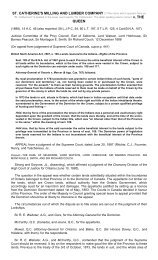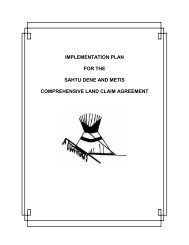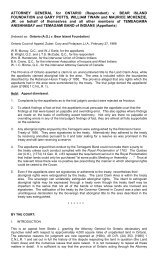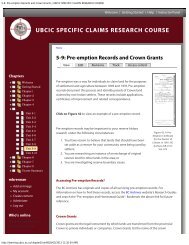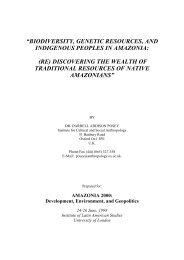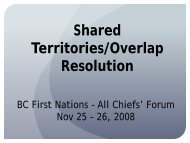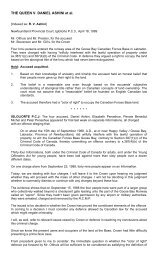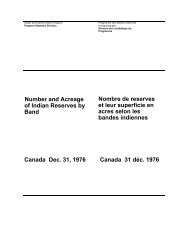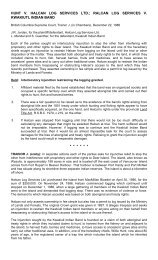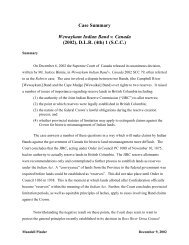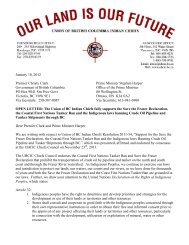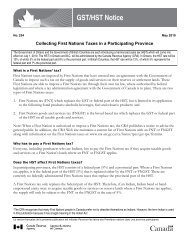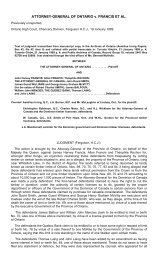Constitutional âPropertyâ and Reserve Creation: Seybold Revisited
Constitutional âPropertyâ and Reserve Creation: Seybold Revisited
Constitutional âPropertyâ and Reserve Creation: Seybold Revisited
You also want an ePaper? Increase the reach of your titles
YUMPU automatically turns print PDFs into web optimized ePapers that Google loves.
20 MANITOBA LAW JOURNAL VOL 32 NO 1made to the First Nation in an effort to induce it to enter into some obligation or to acceptsettlement on a particular parcel of l<strong>and</strong>. 67This analogy between all reserve creation enterprises <strong>and</strong> treaty making is important.Although LeBel J. sources the reserve creation power to the Royal prerogativethere is an issue of representations <strong>and</strong> inducements made to First Nationsregarding reserve entitlements. Embedded in this analysis is an idea that when aFirst Nation moves onto a reserve it is almost like a treaty. Moreover, althoughthere may be no s. 35 right to the reserve initially, the honour of the Crown istriggered when a b<strong>and</strong> occupies a reserve. LeBel J. notes that even a “settingaside” short of the Indian Act triggers the fiduciary obligation of the Crown: “theactions of the Crown with respect to the l<strong>and</strong>s occupied by the B<strong>and</strong> will be governedby the fiduciary relationship which exists between the Crown <strong>and</strong> theB<strong>and</strong>.” 68Justice LeBel’s emphasis on the aboriginal perspective, the honour of theCrown <strong>and</strong> the fiduciary relationship means that a good decision maker will bemindful of this in their analysis of the pith <strong>and</strong> substance of a federal Order inCouncil relating to reserve creation. Where reserve creation may be characterizedas the fulfillment of treaty obligations, the settlement of l<strong>and</strong> claims or moregenerally triggering the honour of the Crown it is clearly in pith <strong>and</strong> substanceabout the federal s. 91(24) powers. This is to say that the purpose of a federalOrder in Council setting aside Crown l<strong>and</strong> for the use of an Indian b<strong>and</strong> canonly truly be discovered in light of the relationship between the Crown <strong>and</strong> aboriginalpeoples. Indeed Justice LeBel J. in Ross River saw it as an elaboration ofthat relationship.4. Impact of the Modern approach to <strong>Reserve</strong> creation on TreatyNo. 3 IRsIn the case of Treaty No. 3 we clearly have a relationship building exercise. Recallthat it was found in R. v. White <strong>and</strong> Bob that Treaty obligations go to the “core” ofs. 91(24). 69 We also have the aboriginal perspective of the Treaty signatories whoexpected reserves to be created for their use <strong>and</strong> benefit. In some cases, treatieseven stipulated that reserves should be “administered by” the Government ofCanada. The courts should be liberal in their approach to treaty interpretation. 70The purpose behind the creation of IR 38B is clearly grounded in unambi-67 Ibid. at para. 65.68 Ibid. at para. 77.69 (1964), 50 D.L.R. (2d) 613 at 618, 52 W.W.R. 193 (B.C.C.A.), aff’d (1965), 52 D.L.R. (2d)481 (S.C.C.).70Nowegijick, supra note 45.



